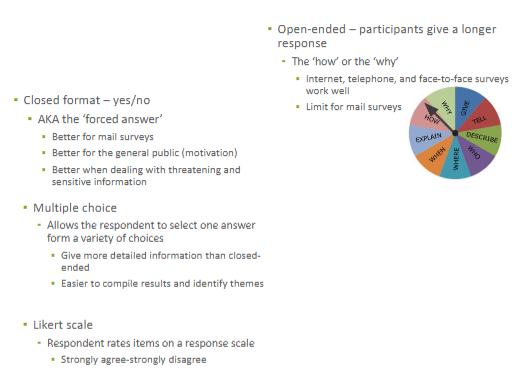Surveys
1/13
There's no tags or description
Looks like no tags are added yet.
Name | Mastery | Learn | Test | Matching | Spaced |
|---|
No study sessions yet.
14 Terms
Mail Surveys
Advantages
▪ Ability to reach large number of people in a short amount of time
▪ Low cost with minimum staff needed (postage)
▪ Possibility of response bias lower than other methods
▪ Same questions delivered in same format to everyone
Disadvantages
▪ Lowest response rate
▪ Inability to clarify any confusion
▪ Incentives to get return
▪ Appearance of questionnaire is important
Electronic Surveys
Advantages
▪ Reduced response time
▪ Low cost of materials
▪ Ease of data collection
▪ Flexibility in the design and format of the questionnaire
▪ Control over the administration
▪ Technology – data can be entered directly into a spread sheet
Disadvantages
▪ Access to the internet and comfort with computer
▪ Obtaining email addresses
▪ Response rate is mixed; no control over answers
▪ Security
▪ Sample bias
Telephone interviews
Advantages
▪Easy
▪Moderate cost
▪Standardized questionnaire
Disadvantages
▪Wireless houses
▪Requires training
▪Bias from clarification
▪No visual data collection
Face to face interviews
Advantages
▪ Allows interviewer to develop rapport with population
▪ Flexibility and visual cues all to gain more complete data
▪ Must train interviewer
▪ Important to establish and FOLLOW procedures
▪ Response rate is usually high
Disadvantages
▪ Time consuming- requires travel
▪ Small number of respondents
▪ More expensive
▪ Require more staff and training
▪ Variation in interviews
▪ differences between interviewers all can influence the results
Types of questions and best practices

Test your questions
▪Validity
▪Face-questions actually measure what you want
▪Content-covering entire concepts of meaning
▪Criterion-scores relate to measure
▪Construct-measuring all aspects
▪Reliability
▪Test-retest
▪Inter-item
consistency
▪Comparison
▪Interrater
reliability
Get help
Making your own
Wording:
▪ Do you believe you should brush 4x a day? vs. How often should you brush your teeth?
▪ Leading questions: Most people seek counseling when they have addiction. Do you believe you should seek counseling?
▪ Double-barreled: Do you brush and floss your teeth?
▪ Jargon: What nutritional benefits are gained by eating healthy?
▪ Specificity: How helpful was this nutrition class? vs. As a result of this class, how prepared are you to assess your food habits?
Types of questions to avoid
▪ Leading questions -Questions worded in a way that sways the reading to one side of the argument
▪ Loaded questions -Written in a way that forces the respondent into an answer that does not accurately reflect his/her opinion or situation
▪ Double-barreled questions-Written to cause the respondents to answer 2 questions at once
▪ Question has two subjects
▪ Using absolutes
▪ Typically yes/no questions with wording “always”, “never”, “every” “all”
▪ Use the respondents language-Use clear, concise, and uncomplicated language
Sampling
▪Do you need to sample ALL of the population or just a sample?
▪Random
▪Systematic
▪Stratified
▪Convenience
▪Snowball
▪Quota
▪Purposive
▪Cluster
Developing a draft
▪Keep your respondents in mind
▪Are the questions applicable
▪Easy to answer
▪Is the first question interesting
▪Put sensitive questions in the middle
▪Demographic questions at the end
Pilot test and final survey
▪Have your respondents take your survey
▪If this is not possible, have others take it and provide feedback
▪Revise
▪Creating the final survey consider:
▪Length
▪Readability
▪Few open-ended questions
▪Good directions
Pilot testing
Types continued:
Cognitive testing = testing with the priority population in small groups with feedback
Pre-pilots = five or six members of the population to assess quality of the materials
Pilot test = actual implementation of the instrument
Can check validity and reliability if enough subjects are used
10% of study population FYI
Types of pilot testing:
▪ Preliminary review
▪ Experts or colleagues review it
▪ Title
▪ Statement
▪ Directions
▪ Order of questions
▪ Questions
▪ Length
▪ Method of returning
What are we looking for in the results
patterns
terms
themes
ideas
Responses
▪ What is it you are looking for?
▪ Assessing the population may be different than evaluating the program.
▪ Identifying ages of participants to plan a program vs.
▪ How well each age group performed on the post-test
▪ Ratio vs. ordinal
▪ How old are you = ratio
▪ Which age range best describes you (15-24, 25-34, 35-44, etc.) = ordinal
▪ Close-ended or fixed responses are better for analysis
▪ Tell us about your experiences vs.
▪ Which of the following best describes your experience (fixed response –Likert scale)